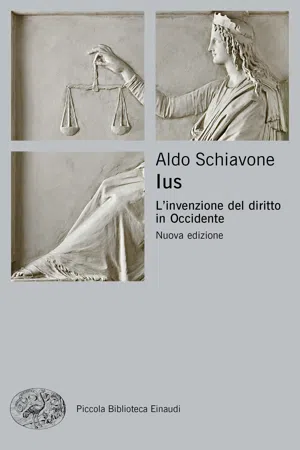Le parole citate nella prefazione sono di M. FOUCAULT, Nietzsche. La Généalogie, l’histoire, in Hommage à Jean Hyppolite, Paris 1971, pp. 145-72 [= Dits et écrits, v.I, Paris 20012, pp. 1004-24], trad. it. in Microfisica del potere, Torino 1977, p. 35.
I. Diritto romano e Occidente moderno.
1. PROCOPIO, Hist. Arc., 6.21; 9.51; 11.1-2; 13.20-23; 14.1, 9-10 e 20; 27.33; 28.9 e 16; 29.15, su cui: A. CAMERON, Procopius and the Sixth Century, Berkeley - Los Angeles 1985, pp. 20, 63, 129, 228, 247, 255 sgg. E. GIBBON, The History of the Decline and Fall of the Roman Empire, ed. Bury, IV, London 1898, pp. 205 sgg., trad. it. Storia della decadenza e caduta dell’impero romano, II, Torino 1967, pp. 1453 sgg., e si veda anche Memoirs of My Life, ed. Radice, London 1984, rist. 1990, pp. 164 sg. e 186.
2. Corpus iuris civilis, vol. I22, edd. Th. Mommsen e P. Krüger, Berlin 1973 (1a ed. Berlin 1872); vol. II14, ed. P. Krüger, Berlin 1967 (1a ed. Berlin 1877), vol. III8, ed. R. Schöll e W. Kroll, Berlin 1963 (1a ed. Berlin 1895).
3. F. BLUHME, Die Ordnung der Fragmente in den Pandectentiteln. Ein Beitrag zur Entstehungsgeschichte der Pandecten, in «Zeitschrift fur geschichtliche Rechtswissenschaft», IV (1820), n. 3, pp. 257 sgg., rist. in «Labeo», VI (1960), pp. 50 sgg., 235 sgg., 368 sgg. (un classico ancora al centro di molta attenzione); F. SCHULZ, Einführung in das Studium der Digesten, Tübingen 1916; F. WIEACKER, Zur Tecnick der Kompilatoren. Prämissen und Hypothesen, in ZSS, LXXXIX (1972), pp. 293 sgg.; D. MANTOVANI, Digesto e masse bluhmiane, Milano 1987 (ove bibl.). Si veda anche piú avanti, nota 11.
4. L. MITTEIS, Reichsrecht und Volksrecht in den östlichen Provinzen des römischen Kaiserreichs: mit Beiträgen zur Kenntniss des griechischen Rechts und der Spatrömischen Rechtsentwicklung, Leipzig 1891; E. LEVY, Westen und Osten in der nachklassischen Entwicklung, in ZSS, XLIX (1929), pp. 230 sgg., e West Roman Vulgar Law. The Law of Property, Philadelphia 1951, nonché Weströmisches Vulgarrecht. Das Obligationenrecht, Weimar 1956; F. SCHULZ, History of Roman Legal Science, Oxford 1946, rist. 1953, pp. 278 sgg., trad. it. Storia della giurisprudenza romana, Firenze 1968, pp. 499 sgg.; F. PRINGSHEIM, Reichsrecht und Volksrecht, in JJP, VII-VIII (1954), pp. 163 sgg.; F. WIEACKER, Vulgarismus und Klassizismus im Recht der Spätantike, Heidelberg 1955, e Vulgarrecht und Vulgarismus, alte und neue Probleme und Diskussionen, ora in Ausgewahlte Schriften, I, Frankfurt am Main 1983, pp. 240 sgg.; TH. MAYER-MALY, «Vulgo» und Vulgarism, in «Labeo», VI (1960), pp. 7 sgg., e l’inchiesta con contributi di vari studiosi, ivi, pp. 228 sgg., 358 sgg., e ivi, VII (1961), pp. 53 sgg., 210 sgg., 349 sgg.; G. G. ARCHI, Giustiniano Legislatore, Bologna 1970, pp. 11 sgg., 151 sgg.
5. M. BRETONE, Storia del diritto romano, Roma-Bari 200410, pp. 353 sgg.
6. I frammenti del Gregoriano e dell’Ermogeniano si possono vedere in Collectio librorum iuris anteiustiniani, a cura di P. Krüger, Th. Mommsen e G. Studemund, III, Berolini 1890, pp. 221 sgg. Sui rapporti fra Gregoriano, Ermogeniano e Codice giustinianeo (opera di cui diremo piú avanti) resta fondamentale G. ROTONDI, Studi sulle fonti del codice Giustinianeo, in Scritti giuridici, I, Pavia 1922, pp. 110 sgg. Anche L. CHIAZZESE, Confronti testuali, Cortona 1937; M. AMELOTTI, Per l’interpretazione della legislazione privatistica di Diocleziano, Milano 1960, pp. 1 sgg.; D. LIEBS, Hermogenians Iuris epitomae: zur Stand der römischen Jurisprudenz im Zeitalter Diokletians, Göttingen 1964; A. CENDERELLI, Ricerche sul «Codex Hermogenianus», Milano 1965; E. DOVERE, De iure. L’esordio delle epitomi di Ermogeniano, Napoli 20052. Del Teodosiano l’edizione di riferimento è quella di TH. MOMMSEN e P. M. MEYER, Theodosiani libri XVI, 1/2, editio secunda, Berolini 1954. Si veda TH. MOMMSEN, Prolegomena, in Theodosiani libri XVI cit., I/1, pp. 9 sgg.; G. SCHERILLO, Il sistema del codice Teodosiano, in Studi Albertoni, Padova 1935, pp. 513 sgg. (= Scritti giuridici, I: Studi sulle fonti, Milano 1992, pp. 241 sgg.); F. DE MARINI AVONZO, La politica legislativa di Valentiniano III e Teodosio II, Torino 19752; G. G. ARCHI, Teodosio II e la sua codificazione, Napoli 1976; T. HONORÉ, The Making of Theodosian Code, in ZSS, CIII (1986), pp. 133 sgg.; E. VOLTERRA, Il problema del testo delle costituzioni imperiali, in La critica del testo, II, Firenze 1971, pp. 821 sgg. (con una tesi non condivisibile).
7. T. HONORÉ, Tribonian, London 1978.
8. CI, 1.17.1: riprendo la trad. italiana da M. BRETONE, Storia del diritto romano cit., p. 382. Sulla polarità iura/leges richiamata alla fine del precedente paragrafo: L. DE GIOVANNI, Istituzioni scienza giuridica codici nel mondo tardoantico. Alle radici di una nuova storia, Roma 2007, spec. pp. 333 sgg., e P. BIANCHI, Iura-leges. Un’apparente questione terminologica della tarda antichità. Storiografia e storia, Milano 2007.
9. Da «digerere»: ordinare, ripartire, registrare, distribuire: ma si trattava, come vedremo, di un titolo usatissimo dalla letteratura giuridica romana sin dall’età tardorepubblicana.
10. Si veda l’Index Florentinus, in Digesta Iustiniani Augusti, editio maior, a cura di Th. Mommsen e P. Krüger, I, rist. Berolini 1962, pp. LII*-LVI*.
11. Ai lavori cit. alla nota 3 si possono aggiungere: A. GUARINO, La compilazione dei «Digesta Iustiniani», in Studi Scherillo, II, Milano 1972, pp. 717 sgg.; A. M. HONORÉ e A. RODGER, How the Digest Commissioners Worked, in ZSS, LXXXVII (1970), pp. 246 sgg.; A. M. HONORÉ, The Editing of the Digest Titles, in ZSS, XC (1973), pp. 262 sgg.; T. HONORÉ, Tribonian cit., pp. 139 sgg.; ID., Justinian’s Digest. Work in Progress, rist. Oxford 1983; D. J. OSLER, The Compilation of Justinian’s Digest, in ZSS, CII (1985), pp. 129 sgg.; M. A. FINO, L’impiego della ‘Appendix’ nella compilazione dei ‘prota’. Studio di un’anomalia, in SDHI, LXVIII (2002), pp. 399 sgg., con altra bibliografia; D. MANTOVANI, Aggiornamenti sull...
